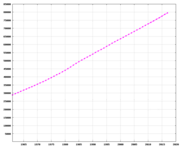Demographics of Turkey

1961–2010
|
|
| Population |
(31 December 2015) |
|---|---|
| Growth rate |
|
| Birth rate |
population (2015) |
| Death rate |
population (2014) |
| Life expectancy |
|
| • male |
|
| • female |
|
| Fertility rate |
|
| Infant mortality rate |
|
| 0–14 years |
|
| 15–64 years |
|
| 65 and over |
|
| At birth | 1.05 male(s)/female (2006 est.) |
| Under 15 | 1.04 male(s)/female |
| 15–64 years | 1.03 male(s)/female |
| 65 and over | 0.84 male(s)/female |
| Nationality | noun: Turk(s) adjective: Turkish |
| Major ethnic | Turks |
| Minor ethnic | Kurds, Albanians, Lazs, Azerbaijanis, Zazas, Chechens, Circassians, Bosniaks, Tatars, Armenians, Greeks, Yazidis |
| Official | Turkish |
| Spoken | Turkish, Kurdish, Albanian, Neo-Aramaic, Laz, Georgian, Bosnian, Bulgarian, Greek, Zazaki, Arabic, Azerbaijani, Kabardian, Armenian, Ladino, Circassian |
This article is about the demographic features of the population of Turkey, including population density, ethnicity, education level, health of the populace, economic status, religious affiliations and other aspects of the population.
In 2010, the population of Turkey was estimated to be 73.7 million with a growth rate of 1.21% per annum (2009 figure). The population is relatively young with 25.9% falling in the 0-14 age bracket. According to the OECD/World Bank population statistics, from 1990 to 2008 the population growth in Turkey was 16 million or 29%.
The figures from the UN Department of Economic and Social Affairs:
Birth statistics of Turkey from 2001 onward are from The Central Population Administrative System (MERNIS) data base which is available on-line. Birth statistics are updated continually because MERNIS has dynamic structure.
In 2010 Turkey had a crude birth rate of 17.2 per 1000, in 2011 16.7, down from 20.3 in 2001. The total fertility rate (TFR) in 2010 was 2.05 children per woman, in 2011 2.02. The crude birth rate in 2010 ranged from 11.5 in West Marmara (TFR 1.52) (11,5;1.55 in 2011), similar to Bulgaria, to 27.9 in Southeast Anatolia (TFR 3.53) (27.1;3,42 in 2011), similar to Syria. Similarly, in 2012, the TFR ranged from 1.43 in Kırklareli, to 4.39 in Şanlıurfa. Deaths statistics from MERNIS are available as of 2009. Mortality data prior to 2009 are incomplete.
Fertility Rate (TFR) (Wanted Fertility Rate) and CBR (Crude Birth Rate):
Total fertility rate by region in Turkey by Turkish General Census(GNS) and Turkish population and health research(TNSA).
Figures from Turkish Statistical Institute (TurkStat):
Structure of the population (2015):
Throughout its history, the Ottoman Empire welcomed altogether hundreds of thousands, maybe millions, of Spanish and Portuguese Jews after 1492; political and confessional refugees from Central Europe: Hungarian revolutionaries after 1848, Jews escaping the pogroms and later the Shoah, Circassians and Chechens from the Russian Empire, Trotskyists fleeing the USSR in the 1930s;
...
Wikipedia
